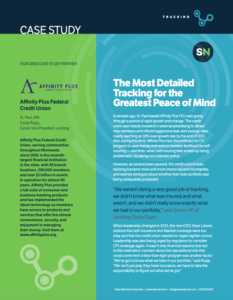Affinity Plus FCU: From CPI Chaos to CPI Confidence
The Most Detailed Tracking for the Greatest Peace of Mind
Affinity Plus Federal Credit Union, serving communities throughout Minnesota since 1930, is the seventh-largest financial institution in the state, with 28 branch locations, 200,000 members, and over $2 billion in assets. In operation for almost 90 years, Affinity Plus provides a full suite of consumer and business banking products and has implemented the latest technology so members have access to products and services that offer the utmost convenience, security, and enjoyment in managing their money. Visit them at www.affinityplus.org.
A decade ago, St. Paul-based Affinity Plus FCU was going through a period of rapid growth and change. The credit union was heavily invested in external advertising to attract new members and offered aggressive loan and savings rates, nearly reaching an 18% loan growth rate by the end of 2011. Also during this time, Affinity Plus had discontinued its CPI program to save money and reduce member feedback by self- insuring — and then, when self-insuring later ended up being problematic, by taking out a blanket policy.
However, as several years passed, the credit union’s loan tracking became more and more imprecise and incomplete, and worries emerged about whether their loan portfolio was being adequately protected.
“We weren’t doing a very good job of tracking, we didn’t know what was insured and what wasn’t, and we didn’t really know exactly what we had in our portfolio,” said Senior VP of Lending Corey Rupp.

When leadership changed in 2013, the new CEO, Dave Larson, realized that self-insurance and blanket coverage were too risky and that the credit union needed to regain tighter control. Leadership was also being urged by regulators to consider CPI coverage again. It wasn’t only financial reasons that led to this realization; concern about the reputational risk that could come from a less-than-tight program was another factor. “We’ve got to know what we have in our portfolio,” said Rupp, “We can’t just pray they have insurance, we have to take the responsibility to figure out what we’ve got.”
